Autumn is well and truly underway, and with the clocks changing in a week’s time winter seems just around the corner. We’ve already got plans in place for the next two years, with a major planting programme scheduled for 2022-23 and a bid for funds to plant shade trees in 2023-24.
Cooling our streets with trees
As temperatures drop, it’s easy to forget that just three months ago the streets of Herne Hill were baking in record heat. That’s going to happen more and more frequently in the coming years, even if governments keep to the 1.5-degree limit of the Paris climate accord.
There’s no doubt that we urgently need more protection from the sun, so we’ve applied for £12,000 through the council’s Cleaner, Greener, Safer (CGS) scheme for 12 new trees to help shade and cool our homes and footways and make summertimes more bearable.
In a heatwave, the outside temperature drops markedly when you walk under a tree. So we’ll be looking at leafy, medium-sized street trees that are fast-growing and drought-resistant to shield residents of all ages from dangerous 40-degree-plus heat when they’re outside and keep the direct sun off their houses.
We’ll be targeting wide residential streets that have unplanted gaps like Holmdene Avenue, Elfindale Road, Frankfurt Road and Danecroft Road, and also streets with heavy school, commuter and shopping footfall like Half Moon Lane and Herne Hill, where larger trees will be suitable. It’s critical that we choose climate-safe species for the project, as this report on the BBC stresses.
Record plantings this coming season
In the meantime, we’re anticipating a record number of new trees arriving during the new planting season, which officially runs from November 1 to March 31. Have a look at the list, where there are details of the locations and species that we’ve agreed with residents, street leaders and Southwark’s tree officers.
The provisional total stands at 82 trees, with more than half - 48 - paid for by CGS. A small number of proposed plantings are still subject to confirmation but there’s also a chance that a few more could be added to the schedule as we should have a small surplus of funds to spend.
If everything goes to plan, by next spring we’ll have helped deliver almost 200 trees to the streets of SE24 in the three years that Herne Hill Tree Watch has been operating.
More lost trees
More than a quarter of the trees due to arrive in the next few months are replacements for ones that have been lost over the years. We keep a close eye on any tree deaths and always press the council to replant - whether that’s recent victims of storm damage and disease or historic losses that we identify from old tree pits.
The latest to go is the northern red oak (Quercus rubra) on Sunray Avenue’s Hillcrest estate that we reported on last month. It was chopped down on October 12, but the big stump was left in place and the hope is that it will regenerate like its neighbour, another red oak that came down a few years ago. That first stump is now regrowing rapidly and its brown autumn leaves sprouting vigorously. Southwark will plant two large trees nearby in the estate grounds to replace the pair of dead oaks.
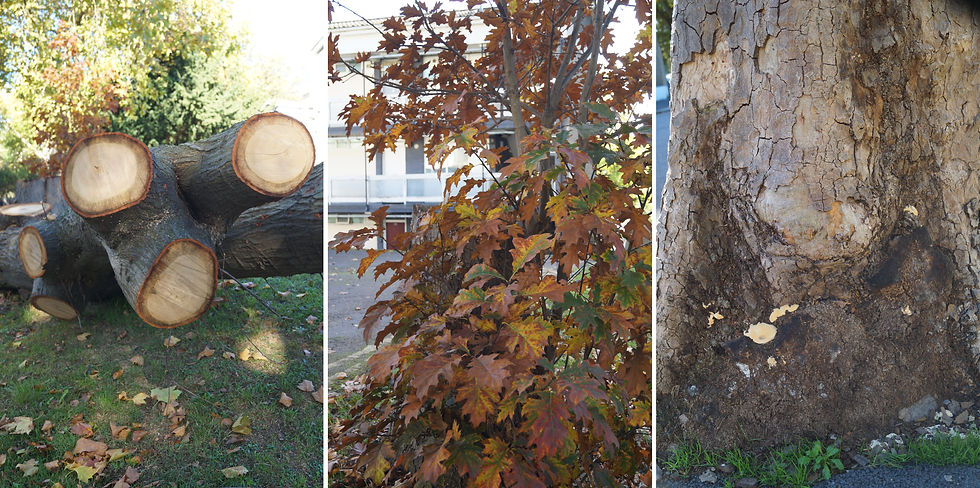
Like the latest red oak, another big tree has just been condemned because of fungal disease and decay. It’s an old plane tree outside 30a Elmwood Road, at the corner of Frankfurt, and in the third picture in the group above you can see what are called the fruiting bodies - the mushroom-like growths - of the fungus on one side of the stem and big black patches of decay on both sides. Any weakening of the base of a big plane makes it a serious safety risk.
Of course this is the second large plane at this junction to succumb to disease, which will have a big visual impact. The one on the opposite corner came down last year. We’ve had a number of fatal fungus infections in the area in recent years, especially from the ganoderma organism.
Early autumn colours
Thanks to the drought and the record-breaking heat of the summer, followed by the sunshine, rain and falling temperatures of the past few weeks, we’re enjoying a beautiful early autumn display from many of our trees. The ever-reliable Yoshino cherries (Prunus x yedoensis) of Stradella Road and Winterbrook Road are now sporting very fetching ginger hats to go with their green summer cloaks.

Some of our tallest trees too are putting on a fine display, like the tulip tree (Liriodendron tulipifera) pictured outside 60 Beckwith Road, with its uniquely shaped butter-coloured leaves; the Turkey oak (Quercus cerris) on the grassy open space on Sunray, in the corner where it meets Nairne Grove; and the 11 silver maples (Acer saccharinum) along Stradella. The maples look fairly subdued from a distance, a pale yellow, but close up their autumn leaves can be stunning.
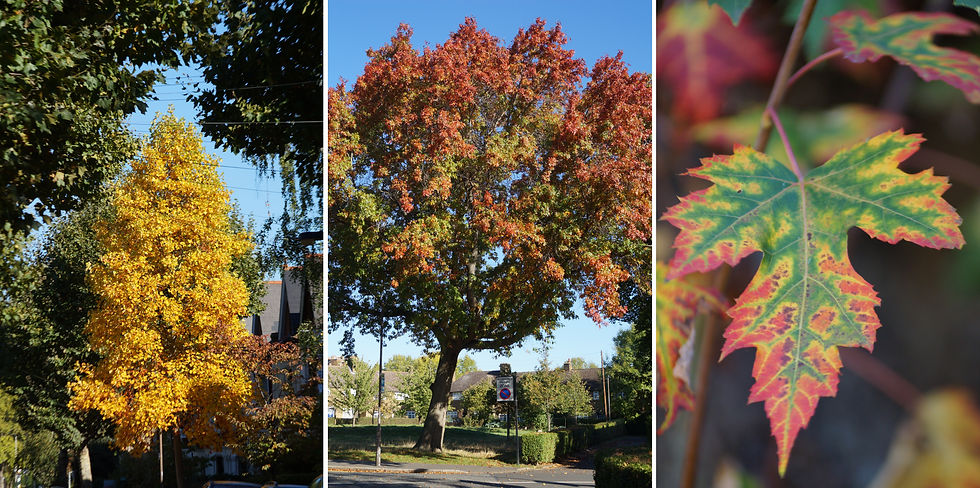
The amazing sweet gums
The trees that really steal the show at this time of year are the sweet gums (Liquidambar). There are dozens of them in Herne Hill, all thriving, and they make a fantastic autumn spectacle, especially along Burbage Road, Stradella and Half Moon Lane. Some of them colour as early as September and many keep their leaves into November.
You’ll recognise them immediately from the photos below, but we’ve noticed there’s a lot of variation among them, particularly in leaf shape and autumn colour. So we set about identifying as many different types as we could.
Common features
The sweet gum fruit is a green capsule about 3 cm in diameter, usually round but sometimes elongated, covered in little tendrils. It persists on the tree for a year until a new batch grows, turning hard, black and spiky.
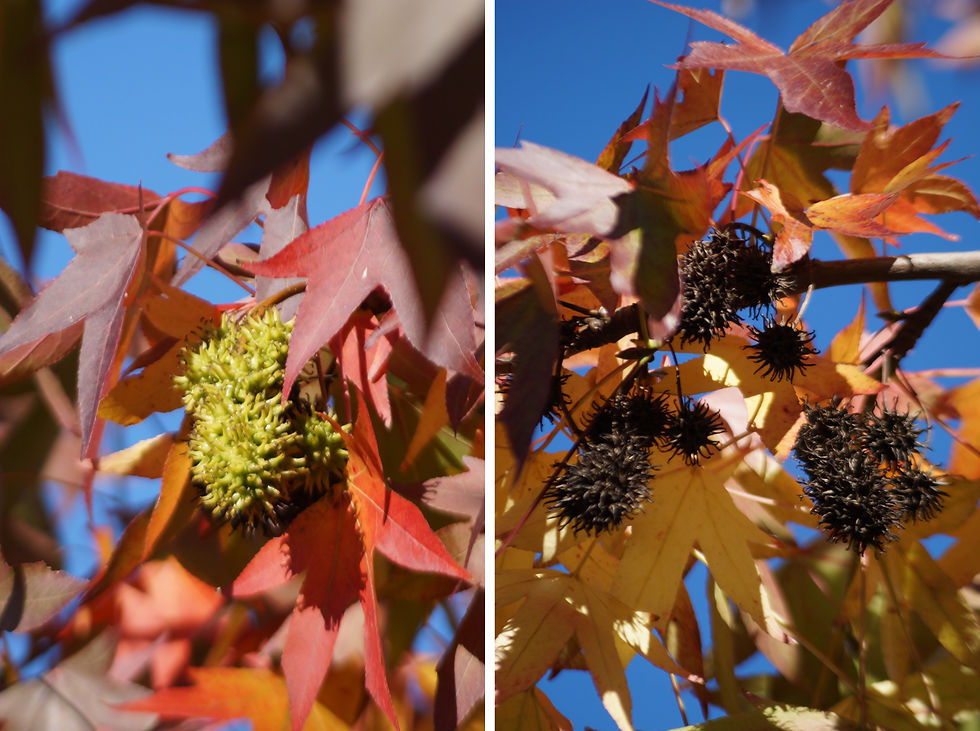
Not every tree bears fruit in UK conditions, though all of them are capable. Only female flowers produce fruit but sweet gums are monoecious - in other words, they have male and female flowers on the same tree. The small, inconspicuous, yellow-green male flowers pollinate the females and then drop off.
The leaves are palmate, meaning they look like the fingers on a hand. They could be confused with maple leaves, but those are ‘opposite’, arranged in pairs along the stem, while sweet gum leaves are ‘alternate’, one after another on different sides.
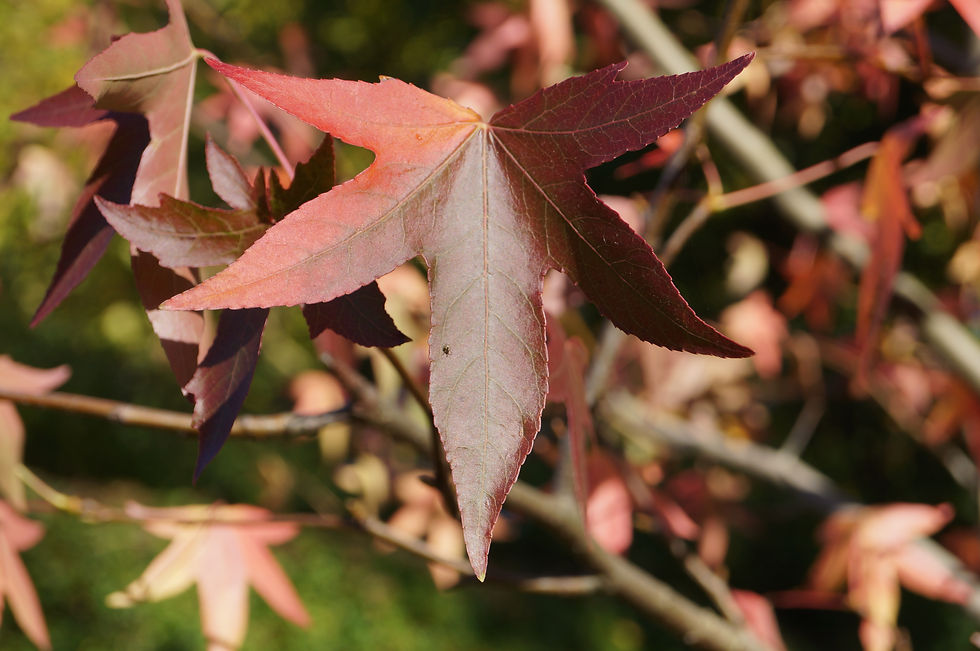
The ‘fingers’ on the leaves are called lobes, and each sweet gum leaf has three, five or seven lobes. Just to confuse things, a single three-lobed tree can sometimes have five-lobed leaves too, and a five-lobed tree can have seven. They can also grow extra spurs on the lobes, making for very complex shapes.
Most sweet gums have a pronounced upright habit, with a strong, vertical central branch that sometimes develops into two parallel leaders. Young trees nearly all have a regular pyramidal outline, although the limbs spread with age and the trees become more egg-shaped. Branches can be brittle and may fall off in storms.
The mid-grey bark is usually deeply furrowed, although on younger trees it’s smooth.
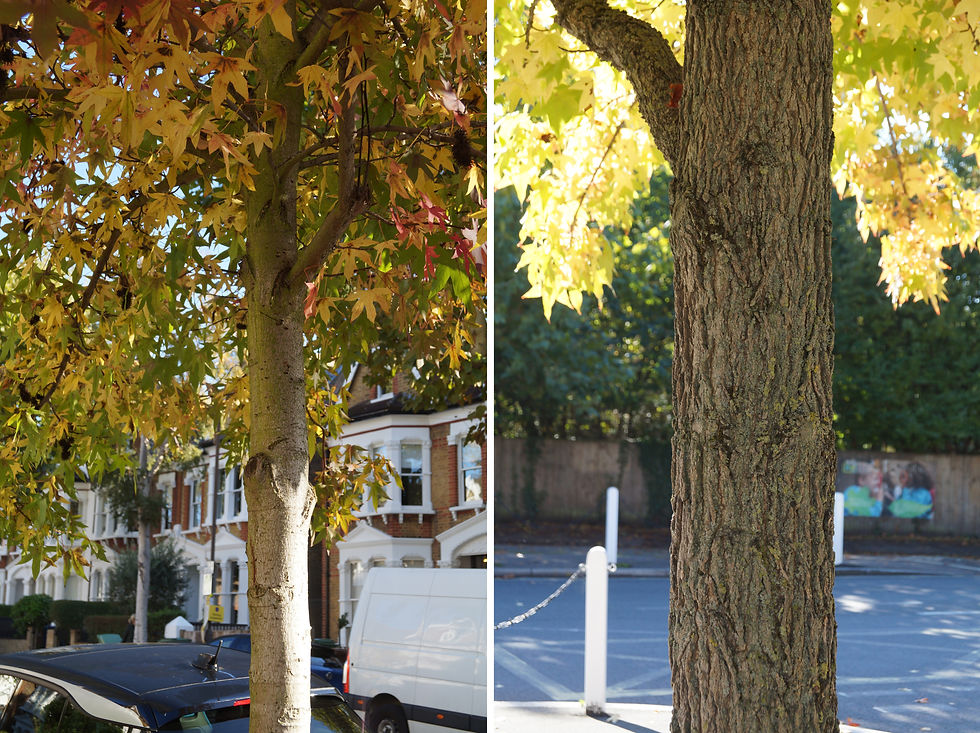
The twigs of older trees often have distinctive corky wings along their length, like elms. The biggest and easiest to make out are at 84 Burbage but others can be seen at 48-50 Burbage and at the corner of Beckwith Road and Half Moon Lane, outside the Wesley Court flats.
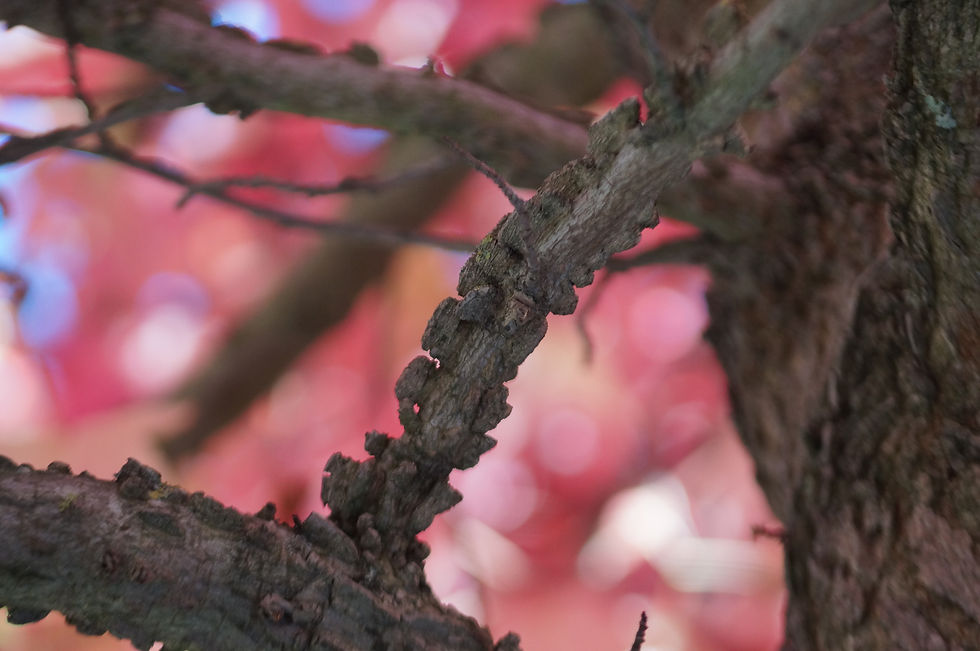
Summer leaf colour is a fairly dark green, but autumn foliage will turn red, yellow, orange, purple or a dark wine shade that’s almost black. Over the course of the season a single tree might show all those colours at the same time. And sometimes two individuals that look identical can turn at completely different times, like this pair at 5-7 Half Moon Lane.

It’s possible that the green one is more sheltered, while its neighbour is more exposed to weather that will favour autumn colours. There’s another big sweet gum which is still green further up Half Moon Lane at no. 133, outside the parade of shops, where it too benefits from its location near a warm, south-facing wall of shops and flats. Whatever the explanation, this succession of colours over many weeks is one of the many virtues of the sweet gum.
Sweet gum species
The Liquidambar genus has only four species:
Liquidambar styraciflua, commonly known simply as sweet gum or American sweet gum. By far the most frequently planted, it’s native to the south-eastern United States and Mexico. There are well over 100 variants, mostly cultivars (created by horticulturists) as opposed to varieties (which are naturally occurring).
Liquidambar acalycina, or Chang's sweet gum. This has three-lobed leaves and originates from southern China.
Liquidambar formosana, or Formosan gum. Another three-lobed tree from east Asia, but differentiated by the hairy underside of the leaf.
Liquidambar orientalis, the oriental sweet gum, native to southwest Turkey. A small, shrubby tree.
Only the first two species can be found in Herne Hill. They’re all called gums because of the sticky resin that oozes out if the bark is cut. The botanical name, Liquidambar, also reflects this, using an antique spelling of amber.
American sweet gum
Almost all the trees here are Liquidambar styraciflua. Some may be simply the ‘species tree’, the one that grows wild, but it’s more likely they’re variants selected to do well on British streets.
The Worplesdon cultivar
One cultivar that we’re fairly confident about naming is Liquidambar styraciflua 'Worplesdon', a hardy tree suited to a cold and wet climate. It’s the one that’s making easily the biggest splash at the moment, decked from tip to trunk in brilliant scarlet.
Here’s a lovely red pillar-shaped Worplesdon at 105 Burbage and one with a more conical habit at 103 Stradella.
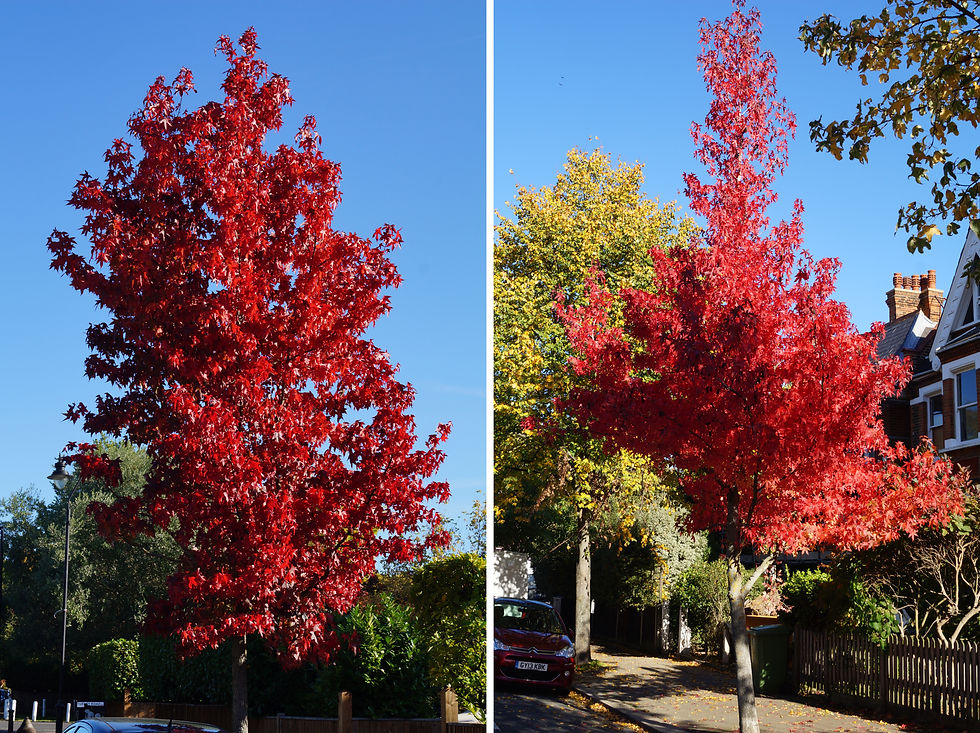
The late afternoon sun glinting through the crown at 103 Stradella really lights up the crimson leaves.
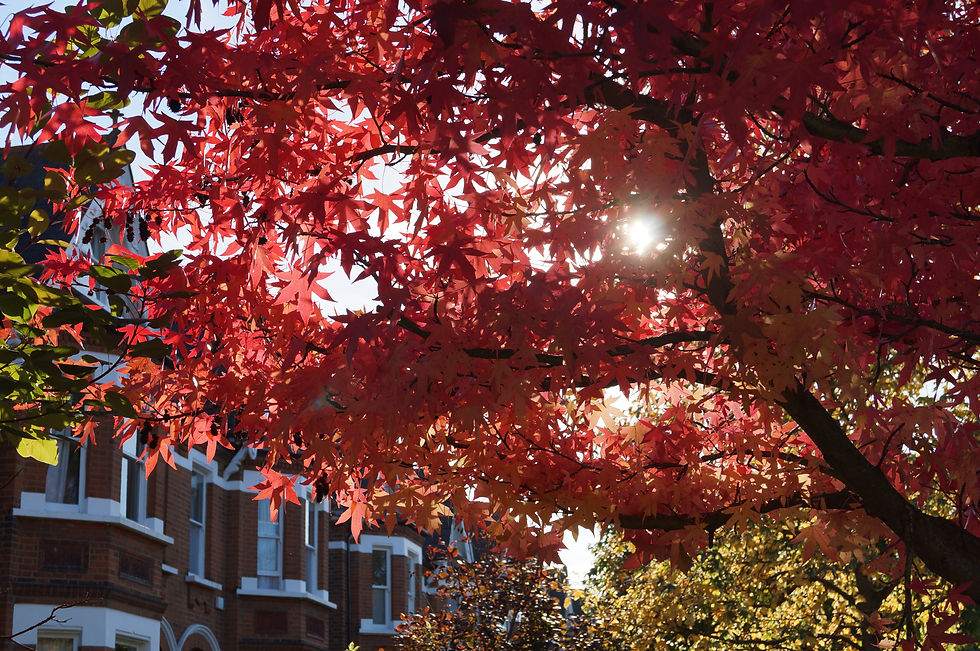
You can see other wonderful examples at 73 Stradella and 41 Burbage, plus a young pair on Holmdene at nos. 49 and 57/59.
The October colour is obviously the biggest giveaway if you’re looking for a Worplesdon, but for ID purposes the leaf lobes are narrower and more angular than the species. This leaf is from a young tree on the grass verge at 18 Sunray Avenue and the big tree shown alongside it grows at 84 Burbage.
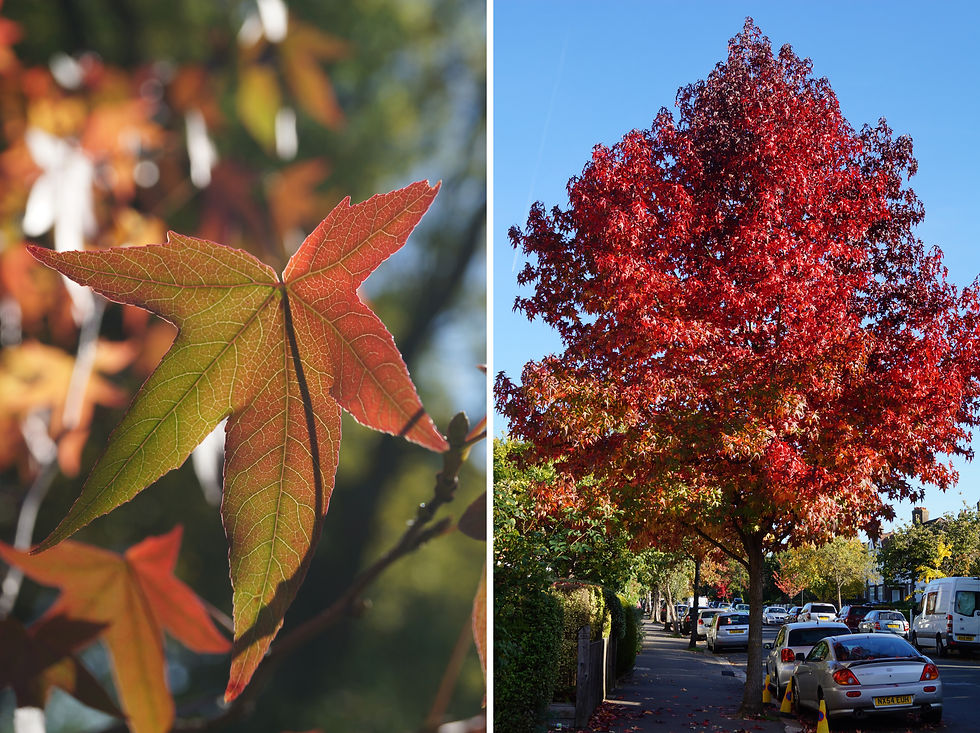
Lane Roberts - the darkest one
There’s a much more sombre red tree at 8 Stradella, the Liquidambar styraciflua 'Lane Roberts’, whose leaves shade from maroon through the colour of Shiraz wine to the darkest plum.
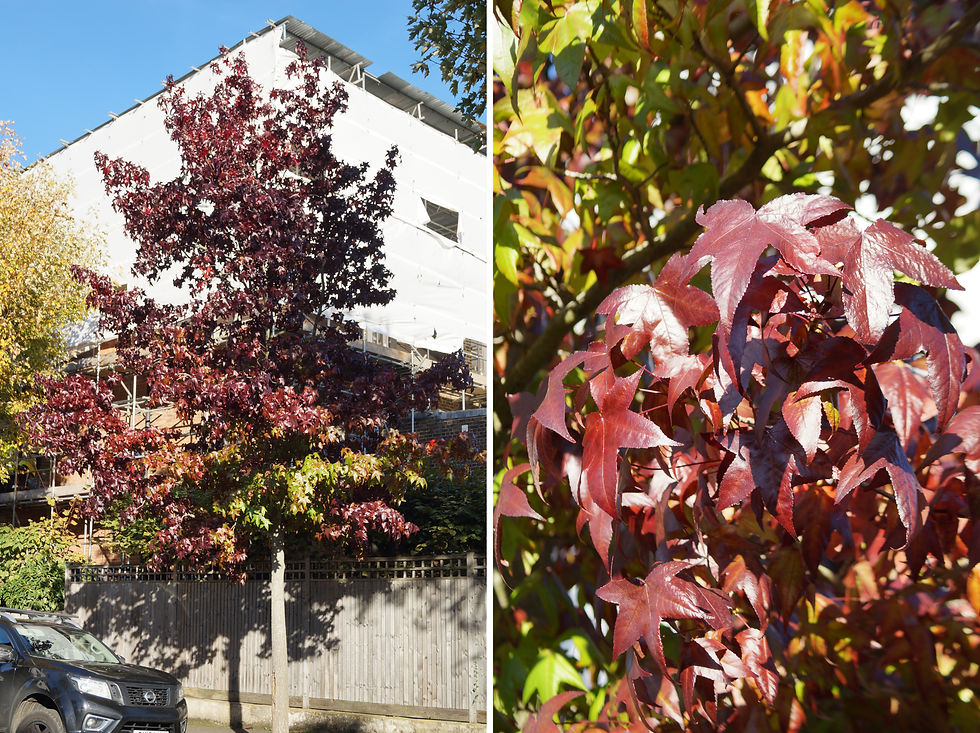
Variegated sweet gum
Actually the easiest local sweet gum cultivar to recognise is Liquidambar styraciflua 'Silver King', because it’s variegated. In summer the very small leaves are green, bordered with creamy-white, but in the autumn they turn pink or dark red in the centre. Looked at from a distance the crown of this tree, at 29 Burbage, appears a pale salmon pink.
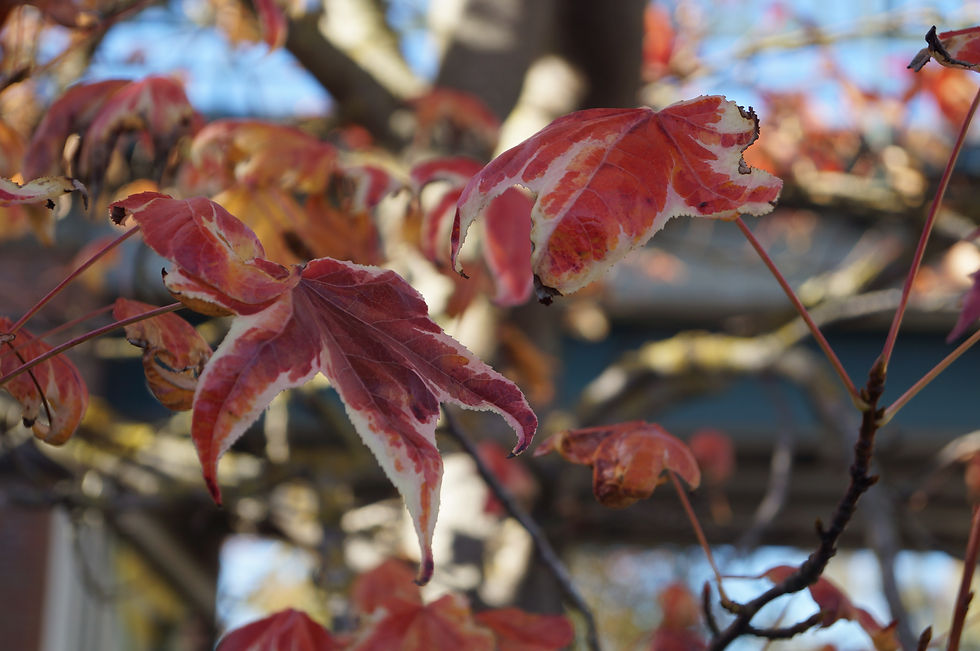
There’s a second Silver King on the other side of the railway bridge, outside the garden of no. 25, and one more at 10 Stradella. These trees must be grafts spliced on to a regular sweet gum rootstock. In both cases there are branches of standard large green sweet gum leaves where the tree has begun to revert to the parent’s features.
Complex leaves
Stradella is also home to a sweet gum with the strangest leaves, the Liquidambar styraciflua 'Stared' at no. 32. They’re ostensibly seven-lobed, but the extra spurs on the lobes give them a more primitive appearance, like a spider crab or a seven-armed starfish. This tree too is only just beginning to colour.
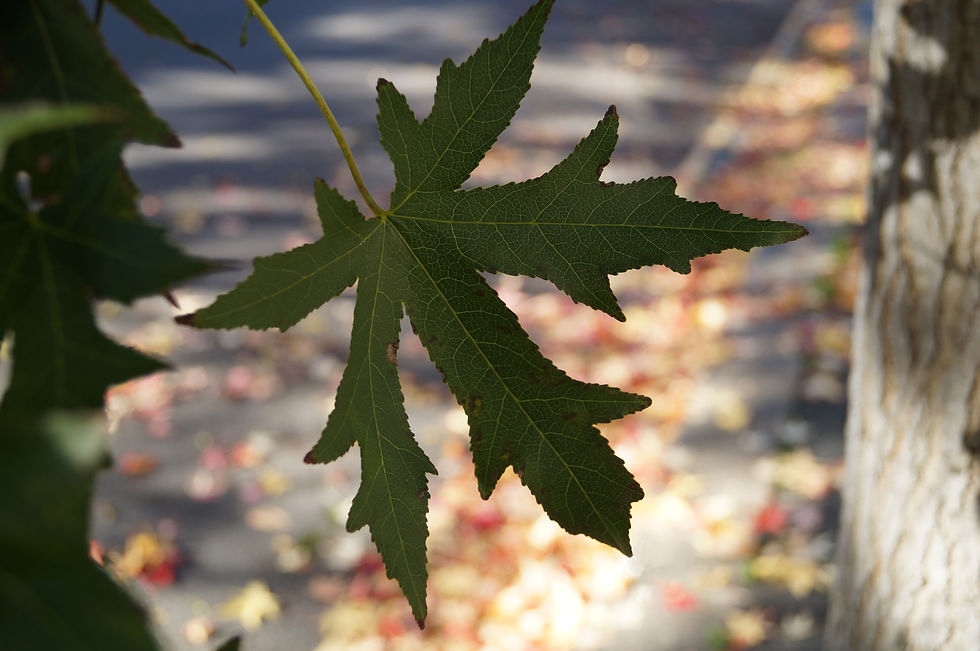
Chang's sweet gum
Finally we come to Liquidambar acalycina, the only three-lobed species in the area. We’ve found two of these, both at the Half Moon Lane end of Stradella. One is on the pavement outside Pedder estate agents, the other is by the gate of the car park behind Pedder. The glossy leaves sometimes have two small additional lobes towards the stalk.
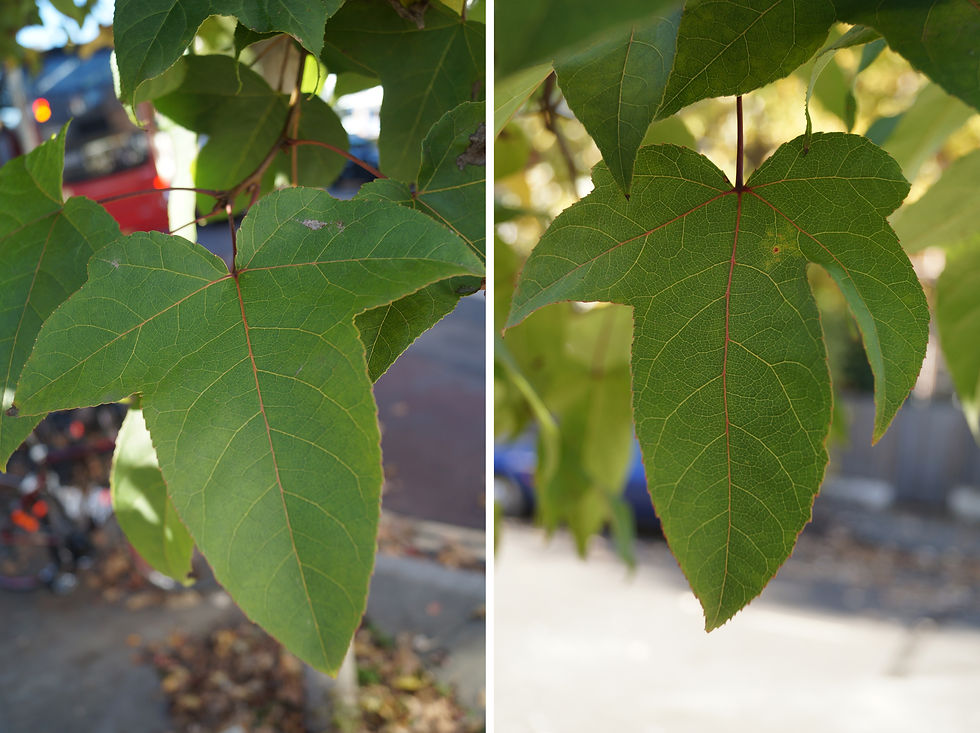
Comments